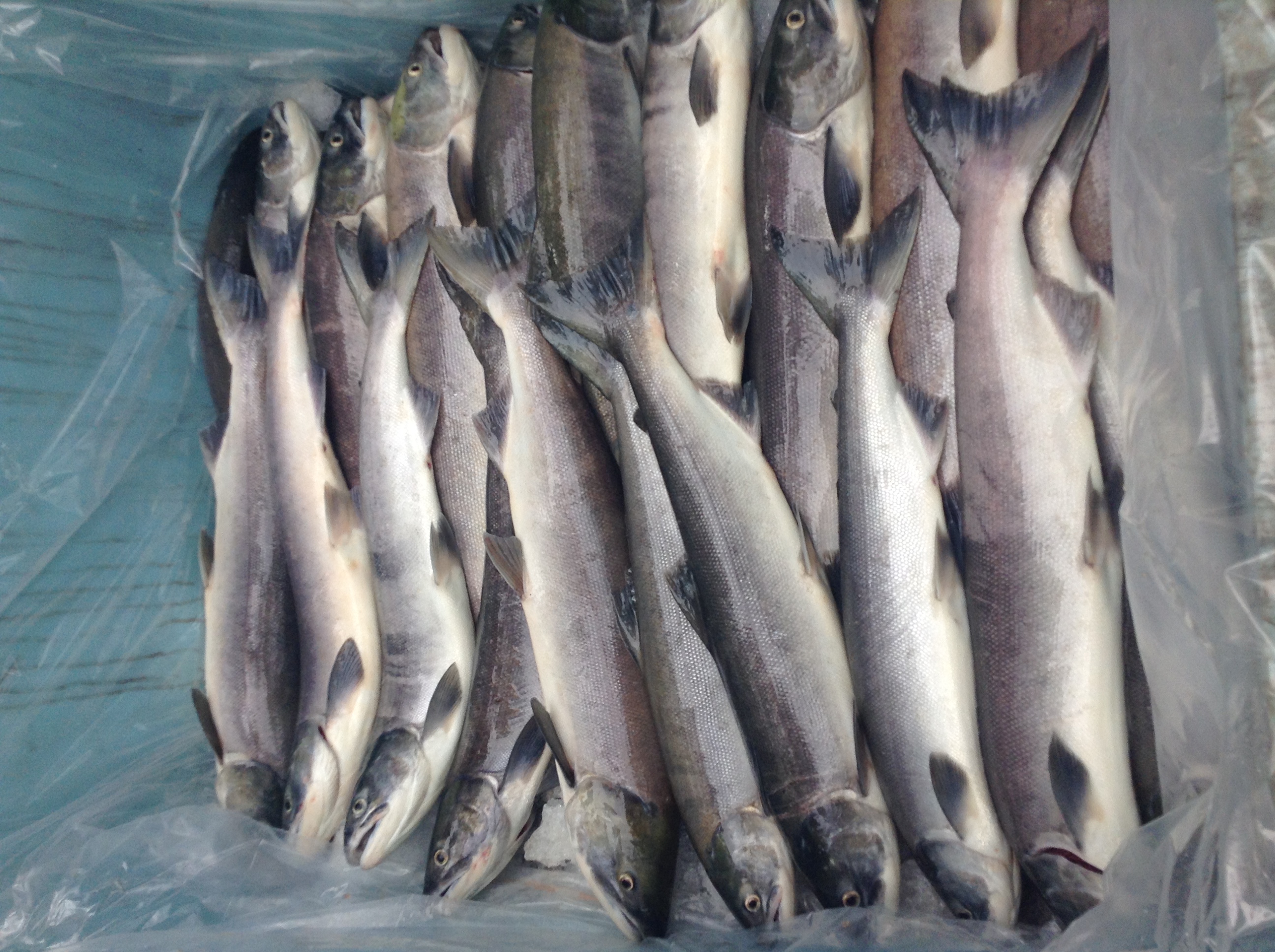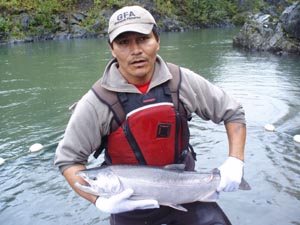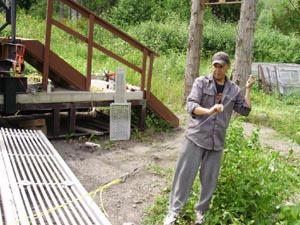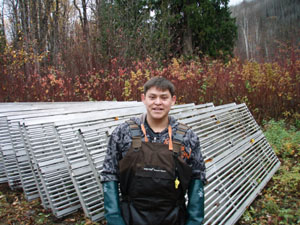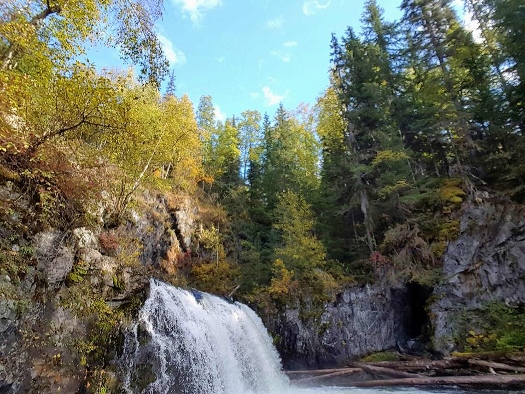
Approximately 70 – 80% of all Nass River sockeye salmon migrate to the Meziadin Watershed to spawn on the beaches of Meziadin Lake and its major tributaries, Hanna, Tintina and Surprise Creeks (Plate, 2003). Meziadin sockeye have and continue to be intensively studied, but relatively little is known about the smaller non-Meziadin populations of sockeye salmon that frequent the waters of the Nass Watershed. One of these smaller non-Meziadin sockeye stocks spawn in Brown Bear Creek, which is located in Gitanyow Traditional Territory in the Huwilp (House) of Gamlaxyeltxw. 2014 marks the 12th consecutive year the Gitanyow Fisheries Authority (GFA) have enumerated sockeye and coho in Brown Bear Creek. Numerous lakes, including dozens originating from the Axnegrelga sub-watershed, feed Brown Bear Creek and water conditions in the stream are usually highly regulated and clear making it an excellent candidate for salmon counting.
.jpg) Fisheries and Oceans Canada (DFO) have kept Salmon Escapement records on Brown Bear Creek since at least the 1970’s, but counts have been sporadic and somewhat incomplete in some years (Kingston 2009, McCarthy 2013). Historical records of escapement for Brown Bear Sockeye show average returns in the 1970’s of less than 100, but as high as 400 fish in 1981. In 2003, the GFA initiated a sockeye and coho salmon enumeration program on Brown Bear Creek, which has continued every year since. Between 2003 and 2011 the estimated escapement of Brown Bear sockeye was highly variable ranging between 6 fish in 2012 and 1240 fish in 2004, while coho returns ranged between 16 fish in 2007 and 130 fish in 2005 (McCarthy 2013).
Fisheries and Oceans Canada (DFO) have kept Salmon Escapement records on Brown Bear Creek since at least the 1970’s, but counts have been sporadic and somewhat incomplete in some years (Kingston 2009, McCarthy 2013). Historical records of escapement for Brown Bear Sockeye show average returns in the 1970’s of less than 100, but as high as 400 fish in 1981. In 2003, the GFA initiated a sockeye and coho salmon enumeration program on Brown Bear Creek, which has continued every year since. Between 2003 and 2011 the estimated escapement of Brown Bear sockeye was highly variable ranging between 6 fish in 2012 and 1240 fish in 2004, while coho returns ranged between 16 fish in 2007 and 130 fish in 2005 (McCarthy 2013).
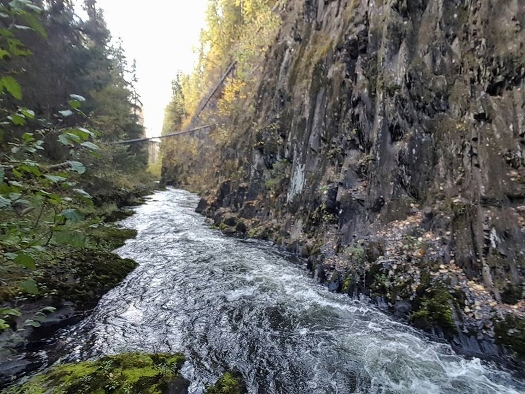
GFA, in conjunction with DFO, will continue the monitoring of the unique river-spawning sockeye and coho in Brown Bear Creek as part of their broader salmon monitoring conducted throughout Gitanyow Traditional Territory.
In 2005 the Canadian Minister of Fisheries announced a new policy titled the Pacific Fisheries Reform (PFR), which came about to improve fisheries conservation, foster First Nations interest in economic fisheries and to help improve the sustainability of BC fisheries. In the same year the first pilot First Nations economic fisheries occurred on the Fraser and Skeena Rivers under this program. Overall, these fisheries have achieved the goals of the PFR and have had positive reviews by DFO management staff and the public in general.
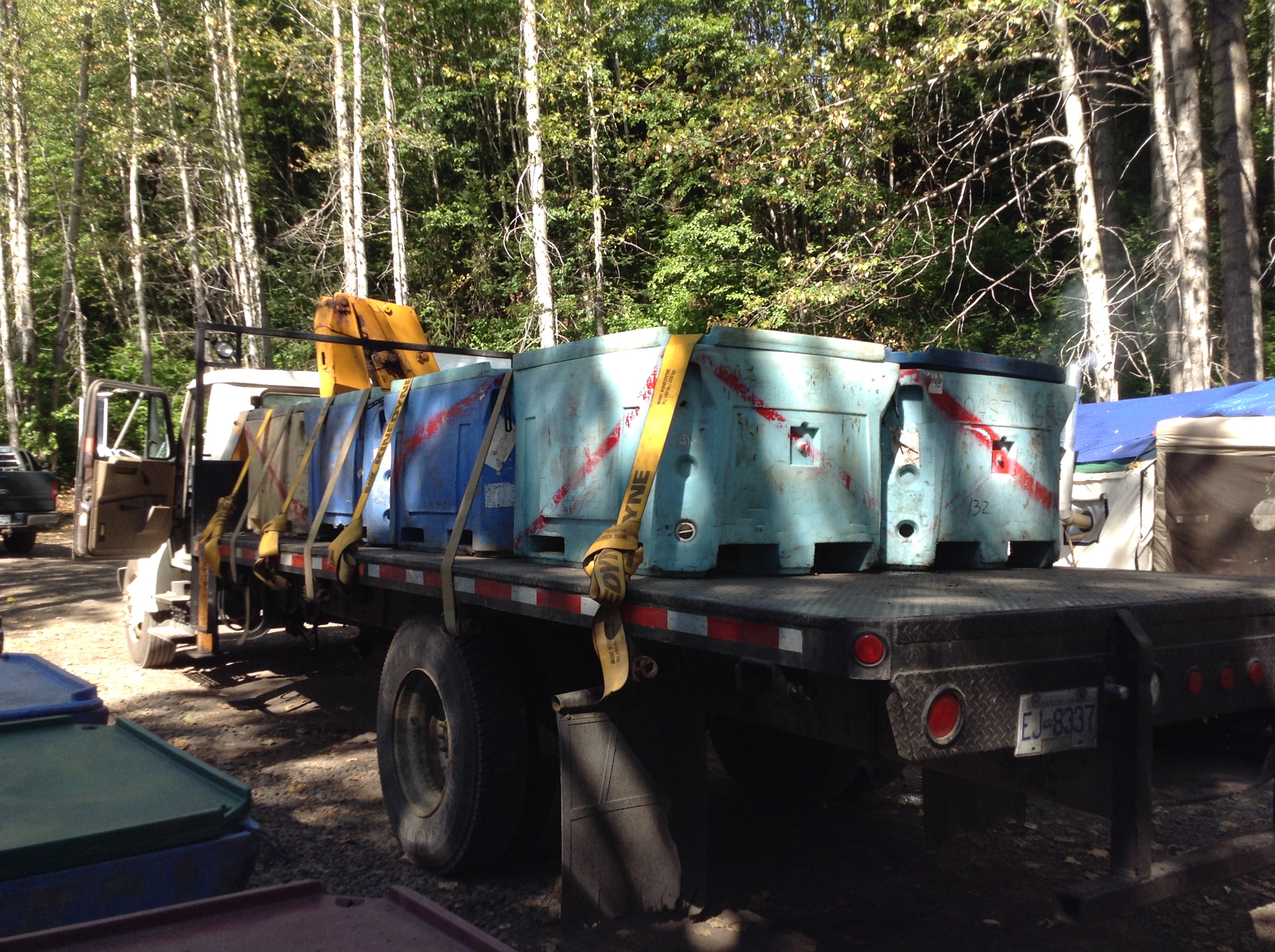
Starting in 2009, the Gitanyow have conducted 2 economic fisheries for sockeye salmon at the Meziadin River fishing site. The first fishery took place from August 17-21 of 2009 and a total of 1,500 fish were harvested. 1,300 of these were shipped to Prince Rupert for processing. With the remaining 200 fish, GFA partnered with the Wet'suwet'en to sell the fish fresh at Moricetown Canyon. The second fishery in 2010 saw the quote increase to 3,000 fish. The bulk of the fish were caught within a few days, and all fish were shipped to Prince Rupert for processing. As in 2009, once expense were paid, all profits were reinvested in the Gitanyow Fisheries program.
As part of managing these fisheries, GFA developed landing slips and fish slips which were reviewed by DFO management staff, and then forwarded to DFO enforcement staff, prior to fisheries occurring. Prior to the implementation of the fishery, DFO management and enforcement staff were notified of the intended start date, were given directions to the landing site and given a list of the designated fishers. While the fishery was taking place DFO fishery managers were updated daily on catch results, and landing / fish slips were also forward to them upon completion of the fishery.
Reviews from DFO staff were extremely positive and the Gitanyow Fisheries Authority was complemented on the professional and organized manner that they conducted the fishery. Fishery Officers noted that channels of communication were kept open and any information that was requested from GFA was produced immediately and was all in good order. Fishery Officers visited the site on five separate occasions and all officers indicated that they were impressed with the orderly fashion that the Fishery was implemented and the cleanliness of the site post fishery.
The Gitanyow hope to build on the success of this small scale, sustainable fishery.
The Gitanyow Traditional Territory lies in the heart of wild salmon country, with salmon having been a staple of their diet for thousands of years. Today, Gitanyow people still rely heavily on salmon, and during summertime each year, the Gitanyow Village smokehouses are fired up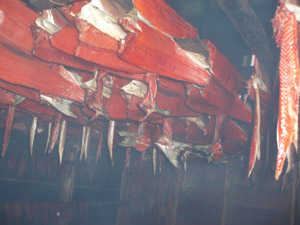 , and people are very busy processing fish
, and people are very busy processing fish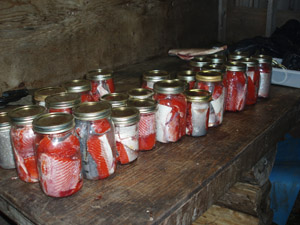 . The Gitanyow Fisheries Authority (GFA) administers and implements the Food, Social and Ceremonial (FSC) Fishery each season, under the specifications as outlined in Schedules A and B-1, and the Appendix to B-1 of the Comprehensive Fisheries Agreement between the Gitanyow Hereditary Chiefs and Fisheries and Oceans Canada (DFO).
. The Gitanyow Fisheries Authority (GFA) administers and implements the Food, Social and Ceremonial (FSC) Fishery each season, under the specifications as outlined in Schedules A and B-1, and the Appendix to B-1 of the Comprehensive Fisheries Agreement between the Gitanyow Hereditary Chiefs and Fisheries and Oceans Canada (DFO).
Under this Agreement the Gitanyow are permitted to fish all salmon species, however sockeye, chinook and coho are the primary species fished. Fishing can occur at certain areas throughout the Gitanyow Territory, with the Meziadin River providing the bulk of the FSC fish for the Gitanyow. 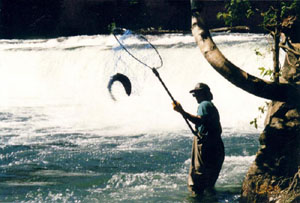 For conservation reasons, the Gitanyow have voluntarily stopped fishing Kitwanga sockeye.
For conservation reasons, the Gitanyow have voluntarily stopped fishing Kitwanga sockeye.
GFA is responsible for:
- Negotiating annually the communal FSC license with DFO.
- Creating a fishing plan in conjunction with DFO.
- Following and implementing an enforcement protocol and catch monitoring.
- Issuing Designation Cards and Transport Permits to Gitanyow members.
Our services and areas of expertise include:
- Technical environmental support for land use planning processes.
Our services and areas of expertise include:
- Analysis and critique of EA applications and pre-EA documents.
- Baseline data collection.
Our services and areas of expertise include:
- Work site isolation and erosion and sediment control for contruction projects.
- Water quality monitoring.
- Road maintenance, specifically with mitigating impacts to roads and aquatic ecosystems from beaver related impacts (flooding roads, damming culverts, blocking fish access). Including breaching dams and trapping.
- Goshawk nest monitoring.
- Harlequin duck population monitoring.
Our services and areas of expertise include:
- Establishment of hydrometric stations, including digital dataloggers and manual gauges.
- Discharge measurement using velocity/depth cross-section or salt-dilution methods.
- Water temperature monitoring using Tidbit loggers.
- Data analysis including creating stage-discharge curves.
Our services and areas of expertise include:
- Closed site electroshocking/minnow trapping for juvenile density estimation.
- Presence/absence surveys.
- Snorkel surveys.
- Streamside salmon enumeration surveys.
- Operation of inclined plane traps, weirs, rotary screw traps.
- Fish capture using seine/dip nets, fishwheels.
Our services and areas of expertise include:
- Site restoration, including re-vegetation for erosion and sediment control (seeding, bioengineering, etc.).
- Instream restoration including LWD placement, rock-line construction, and planning and design related to instream habitat assessment.
- Lakeshore spawning habitat assessment and restoration.
- Side-channel construction.
Our skills and areas of expertise include:
- Lake habitat assessments including spawning habitat quantification.
- Water quality assessment and monitoring.
- PADI certified for diving.
- Stream habitat assessments.
- Habitat restoration and enhancement assessments.
Since 1999, the Gitanyow Fisheries Authority (GFA) has been studying the limiting factors affecting sockeye salmon production in the Kitwanga Watershed. One of the highest assessment priorities for the Kitwanga Sockeye Salmon Recovery Plan (KSRP - initiated in 2006), was to annually monitor the health and abundance of Kitwanga sockeye salmon smolts migrating from Gitanyow Lake, down the Kitwanga and Skeena Rivers, to the Pacific Ocean.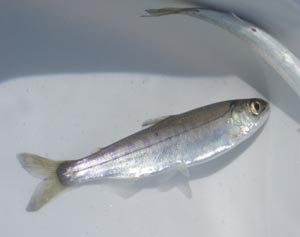
Since 2002, GFA with support from Fisheries and Oceans Canada (DFO) stock assessment biologists, have experimented with different weirs and traps in an effort to accurately enumerate Kitwanga sockeye smolt production.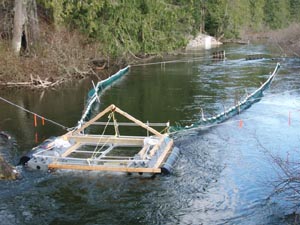 However, the weirs and traps tested all had one major limitation - they were often inoperable during the high water period, which is also the peak of smolt out-migration. Therefore, GFA with the help of DFO engineers, designed a permanent smolt fence that would be constructed from concrete and aluminum at the outlet of Gitanyow Lake (aka Kitwanga or Kitwancool Lake).
However, the weirs and traps tested all had one major limitation - they were often inoperable during the high water period, which is also the peak of smolt out-migration. Therefore, GFA with the help of DFO engineers, designed a permanent smolt fence that would be constructed from concrete and aluminum at the outlet of Gitanyow Lake (aka Kitwanga or Kitwancool Lake).
In 2007, the GFA were successful in acquiring funding from the B.C. Ministry of Forests (MoF), Ministry of Environment (MoE), Gitanyow Hereditary Chiefs (GHC) and DFO to complete Phase I construction of a permanent smolt fence. Phase I consisted of the establishment of a concrete sill in the Kitwanga River from which aluminum transoms could be erected to support fence panels (successfully constructed in the spring of 2007 at a cost of $100,000).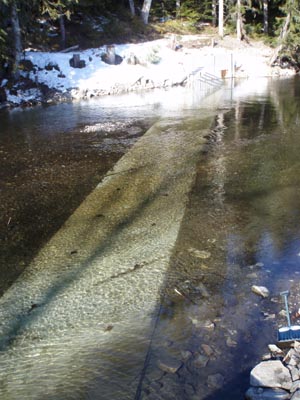 In 2008, the GFA acquired funding from the Pacific Salmon Commission (PSC), MoF, GHC and DFO to initiate Phase II, which included the fabrication and construction of the aluminum fence components to make the permanent smolt fence operational (successfully implemented in March of 2008 at a cost of $100,000).
In 2008, the GFA acquired funding from the Pacific Salmon Commission (PSC), MoF, GHC and DFO to initiate Phase II, which included the fabrication and construction of the aluminum fence components to make the permanent smolt fence operational (successfully implemented in March of 2008 at a cost of $100,000).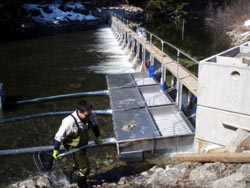
Why is the smolt fence such a vital component in the rebuilding of the Kitwanga sockeye stocks??
1) In 2007 and 2008, hatchery raised sockeye fry were released into Gitanyow Lake. The smolt fence allows a direct calculation of the fry-to-smolt survival rates, as it allows the observation of each smolt for a missing adipose fin - the permanent mark given to the hatchery raised sockeye.
2) The smolt fence allows biologists to get a measure of absolute abundance of sockeye smolts migrating from the system - a measure which is rarely obtained in any field of population biology. In combination with the KRSEF (the counting fence which allows GFA to determine absolute abundance of spawning salmon), GFA biologists are able to calculate the # of smolts produced per female that enters the system, therefore enabling the determination of the overall success of spawning, incubation and rearing (i.e. freshwater survival rates).
3) And also the reverse of that - GFA biologists are able to determine the number of spawners that return based on the number of smolts that migrate from the system, therefore enabling the determination of sockeye marine or ocean survival rates.
In addition to the main benefits of the smolt fence listed above, there have also been some important indirect benefits and uses of the program:
1) The smolt fence captures adult cutthroat trout as they migrate downstream from Gitanyow Lake into the Kitwanga River to spawn.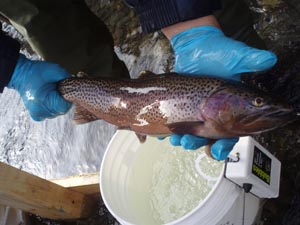 GFA, on behalf of the B.C. Ministry of Environment, has been obtaining valuable age structure (lengths, weights, scales, condition) information from cutthroat trout, as well as applying T-bar tags and assisting in implementation an education program for anglers to record and report the presence of tags in captured fish. As well, GFA is able to enumerate the annual run of cutthroat spawners into the Kitwanga River each spring.
GFA, on behalf of the B.C. Ministry of Environment, has been obtaining valuable age structure (lengths, weights, scales, condition) information from cutthroat trout, as well as applying T-bar tags and assisting in implementation an education program for anglers to record and report the presence of tags in captured fish. As well, GFA is able to enumerate the annual run of cutthroat spawners into the Kitwanga River each spring.
2) Bull trout and Dolly Varden are captured in the smolt fence, as they migrate downstream feeding on sockeye smolts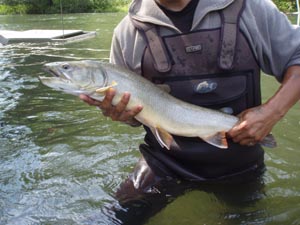 . These fish are enumerated and lengths and weights are recorded, providing valuable information on the annual out-migration of these species from Gitanyow Lake.
. These fish are enumerated and lengths and weights are recorded, providing valuable information on the annual out-migration of these species from Gitanyow Lake.
3) A significant portion of Kitwanga coho rear to smolt stage upstream of the smolt fence, resulting in the fence capturing thousands of coho smolts each season. Opportunistically, in 2009 and 2010, GFA obtained funding to conduct coded-wire tagging of these wild coho smolts, which includes marking them with an adipose fin clip. In 2009-2010, this program was successful in obtaining some of the largest tag groups of wild coho smolts in the entire Skeena watershed. In combination with the KRSEF, GFA is able to determine the rate of return of coded-wire tagged coho salmon, providing a measure of ocean survival rates for these fish.
Overall, the Kitwanga smolt fence has been a major success story, serving as a key component to one of the most robust salmon population monitoring programs in B.C. The biggest challenge of this program will be to maintain funding for it in the long term. Vist our photo gallery for more photos of this project or click here for copies of our updates or reports!
.jpg) The Kitwanga River Salmon Enumeration Facility (KRSEF) has been operating annually since 2003. It is a permanent fence structure with removable panelsdesigned to trap and allow identification and enumeration of upstream migrating salmon. The KRSEF is located approximately 4 km upstream of the Kitwanga - Skeena River confluence, near the village of Kitwanga, B.C. It is arguably the most valuable component of the overall Kitwanga River Sockeye Recovery Plan - a strategy developed in 2006 to rebuild the once abundant Kitwanga sockeye from the point of near extinction. The Kitwanga sockeye have been a vital resource for the Gitanyow people, who have relied on the run for food for thousands of years, and who have voluntarily stopped fishing the stock since the early 1970's.
The Kitwanga River Salmon Enumeration Facility (KRSEF) has been operating annually since 2003. It is a permanent fence structure with removable panelsdesigned to trap and allow identification and enumeration of upstream migrating salmon. The KRSEF is located approximately 4 km upstream of the Kitwanga - Skeena River confluence, near the village of Kitwanga, B.C. It is arguably the most valuable component of the overall Kitwanga River Sockeye Recovery Plan - a strategy developed in 2006 to rebuild the once abundant Kitwanga sockeye from the point of near extinction. The Kitwanga sockeye have been a vital resource for the Gitanyow people, who have relied on the run for food for thousands of years, and who have voluntarily stopped fishing the stock since the early 1970's.
Although the fence was primarily constructed to enumerate sockeye, it is strategically located and operated to enable the enumeration of all species of Kitwanga River salmon - a feat which has been accomplished in most years since it was built. 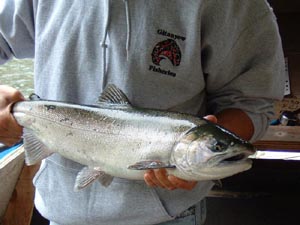 In addition to providing a measure of absolute abundance of Chinook, sockeye, pink, chum and coho salmon, the fence also allows the capture of fish and the observation of condition. In 2010, GFA crews captured a percentage of sockeye, Chinook, chum and coho salmon and collected information on fish length, age (through collecting scales), DNA and sex. For sockeye and coho, crews observed each fish for missing adipose fins. In 2007 and 2008, GFA released hatchery raised sockeye into the upper Kitwanga watershed, clipping the adipose fins to mark them. These fish were then enumerated as they migrated to the ocean as smolts, through another GFA facility - the Kitwanga Smolt Enumeration Facility. At this facility, each smolt was observed, enumerated and observed for a missing adipose fin. Through the use of these two facilities, GFA can determine with accuracy the overall success of the hatchery program, by calculating the rate of smolt survival from fry stage, and the rate of return of sockeye spawners based on the number of smolts that migrated to sea.
In addition to providing a measure of absolute abundance of Chinook, sockeye, pink, chum and coho salmon, the fence also allows the capture of fish and the observation of condition. In 2010, GFA crews captured a percentage of sockeye, Chinook, chum and coho salmon and collected information on fish length, age (through collecting scales), DNA and sex. For sockeye and coho, crews observed each fish for missing adipose fins. In 2007 and 2008, GFA released hatchery raised sockeye into the upper Kitwanga watershed, clipping the adipose fins to mark them. These fish were then enumerated as they migrated to the ocean as smolts, through another GFA facility - the Kitwanga Smolt Enumeration Facility. At this facility, each smolt was observed, enumerated and observed for a missing adipose fin. Through the use of these two facilities, GFA can determine with accuracy the overall success of the hatchery program, by calculating the rate of smolt survival from fry stage, and the rate of return of sockeye spawners based on the number of smolts that migrated to sea.
The reason that coho salmon in 2010 were missing adipose fins is that in 2009, GFA crews started a coded-wire tagging program for coho smolts captured at the smolt enumeration facility, and marked them with an adipose clip. This allows GFA biologists to determine the ocean survival rates of wild coho smolts that migrated from the system, and will provide DFO and GFA fisheries managers with information on coho harvest rates and harvest locations at sea.
.jpg)
Each year in early July, before salmon start entering the Kitwanga River, GFA crews install the panels and counting boxes to a concrete sill that exists permanently in the river. The panels block upstream access for spawning fish and the counting boxes are then staffed during typical salmon migration times (morning and evening) to allow crews to identify and count every fish as they pass upriver. When the counting boxes are opened by staff, fish are able to migrate upstream through one of two boxes, located on each side of the river. On each side they can swim through one of two chutes where they pass over a white teflon surface that provides contrast and aids in observing identifying features of the fish. With a plexiglass box floating on the water surface, the glare is reduced. The chutes can be adjusted to an optimum depth that permits easy movement for fish and is still shallow enough to get a good look at the fish. 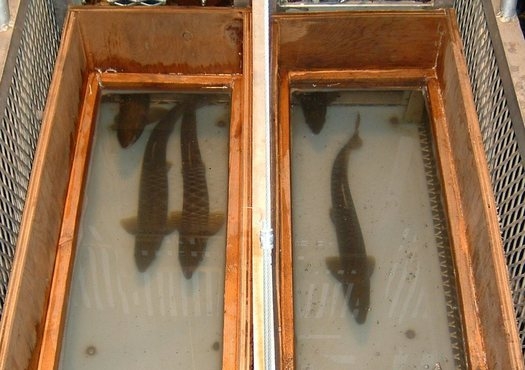 Fish are enumerated each year, typically until mid to late October until the runs have moved upstream past the fence and the water levels get too high to keep the fence in.
Fish are enumerated each year, typically until mid to late October until the runs have moved upstream past the fence and the water levels get too high to keep the fence in.
The KRSEF has arguably been one of B.C.'s most successful salmon spawner enumeration projects over the last decade. It provides valuable information to Gitanyow and DFO fisheries biologists and managers. In combination with the Kitwanga Smolt Enumeration Facility, GFA has been able to calculate the smolt production per female sockeye spawner - a key metric that has proven that Gitanyow Lake (aka Kitwanga or Kitwancool Lake), is one of the most productive sockeye nursery lakes for it's size in B.C. By getting an absolute count of sockeye, and all salmon species in the Kitwanga River, on an annual basis, it provides another indicator of the impacts of coastal and in-river commercial economic fisheries.
For the Gitanyow people it is a key tool in enabling them to restore stability to the Kitwanga sockeye - a genetically unique sockeye stock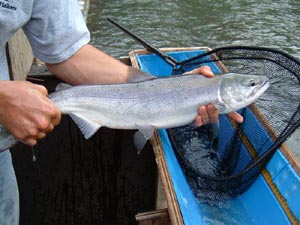 .
.
For more photos of the KRSEF, or other GFA projects, go to our photo gallery. For updates from the KRSEF and copies of reports, click here.
The Gitanyow Fisheries Authority primarily works within the Gitanyow Traditional Territory (Lax Yip). However, at times our work extends beyond those boundaries. For example our fisheries team has conducted work on a consulting basis on a run-of-river hydroelectric project on Sedan Creek - located in Gitxsan Traditional Territory. As well our technicians have been assisting Rescan Environmental Services Ltd. to collect baseline data at the site of the proposed Kerr-Sulpherets-Mitchell mining project, located just north of and in watersheds that flow into Gitanyow Territory. The Gitanyow Territory includes large sections of 2 major watersheds - the Kitwanga and Nass Rivers. It also includes significant sections of the upper Kispiox River in the Swan Lakes area, which is a tributary to the Skeena River. While travelling north on Highway 37 from Kitwanga, B.C., you encounter the southern territory boundary at ~ 12 km, and the northern boundary at ~187 km, where the Bell-Irving River crosses the highway. View the Gitanyow Territory map for a better look at the territory.
Our office is located in the village of Gitanyow, which is located ~21 km north up Highway 37 from the Highway 16 and 37 junction at Kitwanga, B.C. The blue placemarker on the map below shows our office location. Click the Gitanyow Village icon below the map to enlarge and zoom in.
View Gitanyow Village in a larger map
Gitanyow Moose Harvest Survey and Permitting Program
Here's what's happening at GFA:
Kitwanga Smolt Fence Enumeration summary
Click here to read an OVERVIEW of the
Kitwanga Smolt Enumeration FACILITY »
Below, you'll find updates from the fence posted here during the smolt fence season of operation (mid-April - late June) in .pdf form. You'll also find copies of past annual reports. Stay tuned as more info is posted on our site.
2015 Kitwanga Sockeye Smolt Enumeration
2014 Kitwanga Sockeye Smolt Enumeration
2013 Kitwanga Sockeye Smolt Enumeration
2012 Kitwanga Sockeye Smolt Enumeration
2011 Kitwanga Sockeye Smolt Enumeration
2010 Kitwanga Sockeye Smolt Enumeration
2009 Kitwanga Sockeye Smolt Enumeration
Kitwanga River Salmon Enumeration Facility UPDATES
Click here to read an OVERVIEW of the
Kitwanga River Salmon Enumeration FACILITY »
Below, you'll find .pdf downloads of our KRSEF updates and past annual reports. Stay tuned as more documents are posted on our site.
The Gitanyow Fisheries Authority (GFA) currently employs 3 full-time biologists and a full-time fisheries coordinator. GFA employs 8-14 seasonal technicians, labourers and student workers that typically work each year during the field season from mid-April to mid-November.
Current Full-Time Staff
Gregory Rush - Fisheries Coordinator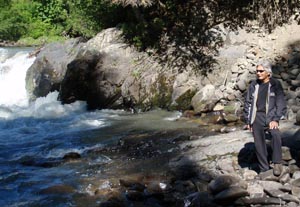
Gregory is the head Chief of the Gitanyow wilp (house group) of Wii Litsxw (Meziadin Lake area). In his role at GFA he is in charge of administering the Aboriginal Fisheries Strategy funding provided by Fisheries and Oceans Canada. He manages the Food, Social and Ceremonial (FSC) Fisheries each year for the Gitanyow, including issuing Designation Cards and Transport permits to community members to allow them to legally obtain their FSC fish. He is active in negotiations with industry and government in relation to management of natural resources on the Gitanyow Territory.
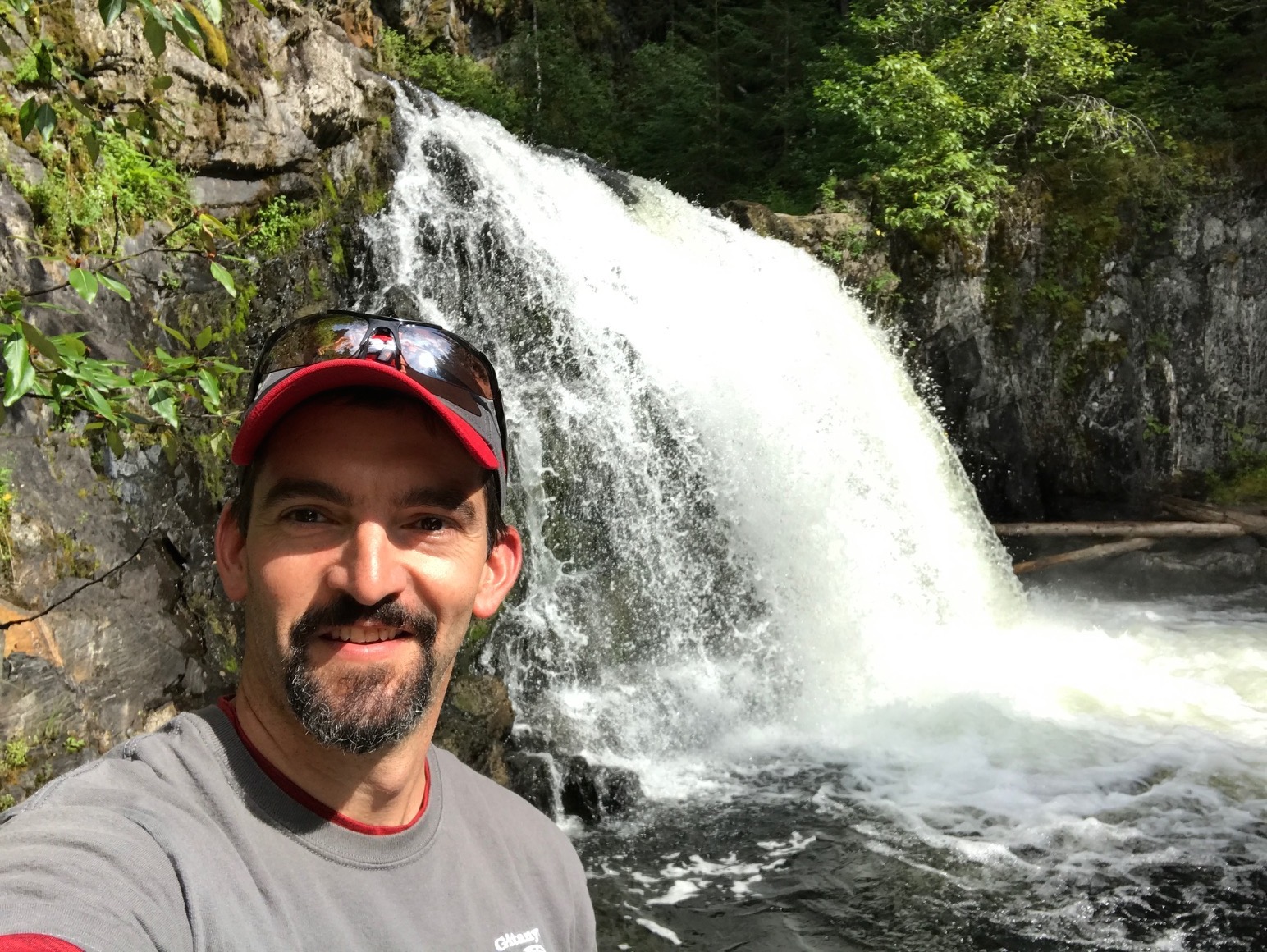 Mark Cleveland - Head Fisheries Biologist
Mark Cleveland - Head Fisheries Biologist
Mark has been employed by the Gitanyow Fisheries Authority since 1999. He has been a Registered Professional Biologist in BC in good standing since 2003 and holds a degree in Biology from the University of Northern British Columbia (UNBC) in Prince George, BC. He also has technical diplomas in fish and wildlife and Natural Resources Law Enforcement from Sir Sandford Fleming College in Lindsay, Ontario. Mark has over 20 years experience working in the natural resources sciences, including time spent in working for government, industry and consulting in parks, forestry and fisheries. He has extensive in fish and fish habitat assessment, salmonid stock assessment, fisheries management, project management and environmental impact assessment. Mark oversees all aspects of GFA technical activities, including budgeting, staffing, proposal writing, field work supervision and reporting. He also represents First Nation interest in fisheries at the provincial level through his work with the First Nations Fisheries Council and at a regional level through the Skeena Fisheries Commission. He is also a senior technical advisor to Gitanyow Nation leaders at many resource management tables acting as the direct link between science and the politics of decision making.
Kevin Koch - Fish and Wildlife Biologist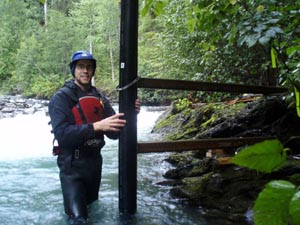
Kevin holds a BSc. in Wildlife Management from UNBC in Prince George, BC, and has over 12 years experience in fisheries, wildlife and forestry management in Northwest B.C. He has extensive experience in stream habitat assessment and restoration, including in-stream and riparian habitat work, as well as salmonid enumeration including snorkel surveys. His role at GFA is diverse and has included management of the Sedan Creek Hydro-electric fisheries assessment, working in the field with GFA technicians doing QA/QC, assisting the Gitanyow Hereditary Chiefs in developing wildlife management capacity and providing technical support for environmental assessment review processes.
Jordan Beblow - Fisheries Biologist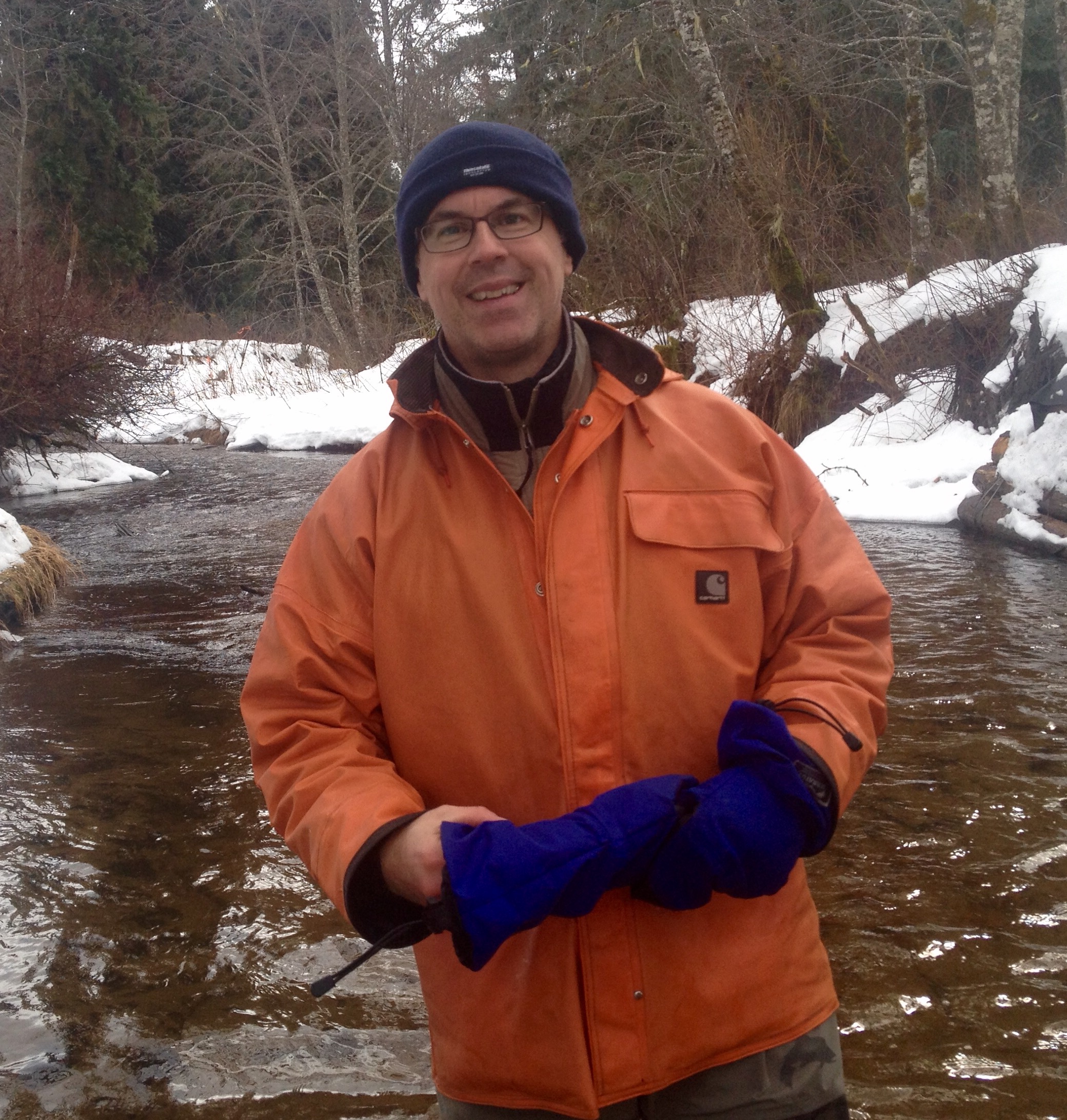
Jordan is a Registered Professional Biologist in BC in good standing, and received his Bachelors of Science degree from the University of British Columbia (UBC), and was fortunate to work for five years at the university later in his career in research with the Sea Around Us Project. In addition to working in a research setting, his past work background for government (DFO, MoE), and in consulting, has broadened his outlook and perspective of how the different sectors operate and work with First Nations and industry on environmental questions. Jordan has combined his 20 years of field experience in the Natural Resource sector with strong organizational and technical writing skills with a love of the natural world to perform tasks in a timely and ethical manner.
GFA Seasonal Staff
Vernon Russell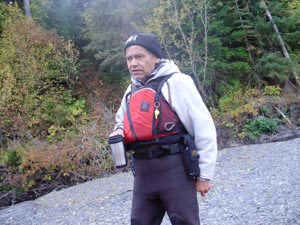
Vernon has worked with GFA since 1998 and brings a wealth of knowledge and discipline to our crews. He knows the Gitanyow Traditional Territory very well. Prior to GFA he worked as a faller and a commercial fisherman. He is known on the crew for his excellent note-taking abilities and his high level of professionalism.
Les McLean
Les has been with GFA for over 16 years. He has a wealth of knowledge of the Gitanyow Traditional Territory, and excellent technical skills. Les works on all GFA projects and typically is stationed locally at our enumeration fences. In October/November 2010 he completed the Aboriginal Environmental Technician Certificate Course (AET) and the Environmental Monitoring for Construction Projects (EM) course through Vancouver Island University (VIU).
Earl McLean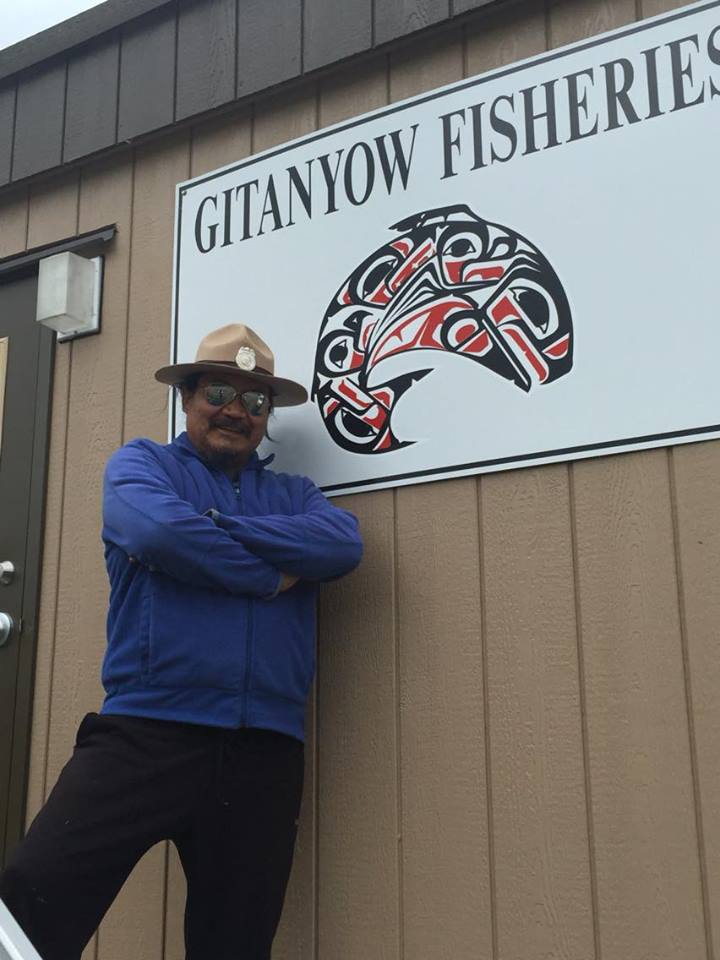
Earl has been with GFA for over 15 years. He has a wealth of knowledge of the Gitanyow Traditional Territory, and an excellent technical skills. Earl works on all GFA projects and has been the lead on the Parks and Rec Site Maintenance Project with the Ministry of Forests over the last few years. In October/November 2010 he completed the Aboriginal Environmental Technician Certificate Course (AET) and the Environmental Monitoring for Construction Projects (EM) course through Vancouver Island University (VIU).
Phillip Johnson
Phillip has worked for GFA for over 14 years. He typically spends the bulk of the field season working in partnership with the Nisga'a Fisheries Program at the Meziadin Fishway. In October/November 2010 he completed the Aboriginal Environmental Technician Certificate Course (AET) and the Environmental Monitoring for Construction Projects (EM) course through Vancouver Island University (VIU).
Brenton Williams
Brenton has worked for GFA for over 7 years. Brenton works on all GFA projects but spends most of the season working at both the Kitwanga adult and smolt fences. He also spends much of the field season as a fisheries technician at the Meziadin Fishway. As a veteran technician, Brenton often works on various industrial projects such as mines and pipelines, providing technical assistance.
Morgan Douse
Morgan Douse started out as a Student Worker in 2012 and has been with us ever since, working in both an office and field capacity. Her eagerness to learn new things, her personable nature and her competency with computers has given her opportunities to work in the office with data management, preparation of the company health and safety manual and updating the GFA website. She has also worked on most of GFA's field projects, including the adult fence, Brown Bear Creek sockeye counts and monitoring of the commercial fishery at Meziadin, to name a few.
Johnny Martin.jpg)
Johnny started with GFA in 2012 as a summer student, spending much of his first season doing stream assessments for pipeline projects. Since that time he has spent much of each summer working as a fisheries technician at the Meziadin Fishway, and has represented Gitanyow well in this capacity. He has also worked on both the adult and smolt fences and most other GFA projects, and has become a very versatile emerging leader on the GFA team.
The GFA is mandated to conserve, protect, restore, monitor and manage fish, wildlife and the habitat they require, within the Gitanyow Lax Yip (Traditional Territory).
link summary
First Nations Organizations
The Gitanyow Fisheries Authority is an arm of the Gitanyow Hereditary Chiefs Office. See Where We Work, Our Mandate and Our Team for more info.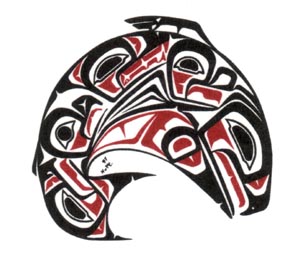
The Gitanyow are active in fishing, and the Gitanyow Fisheries Authority (GFA) plays a key role in those efforts. GFA biologists and fisheries managers are active in negotiating and planning with Fisheries and Oceans Canada (DFO) on sustainable quotas, and in determining if and when fisheries can occur. GFA projects such as the Kitwanga River Salmon Enumeration Facility are vital in determining if certain runs can be fished, and when those fisheries can occur. The GFA fisheries coordinator and other staff play a key role in monitoring any fisheries on Gitanyow Territory, and have established excellent relationships with DFO Fisheries Enforcement personnel. 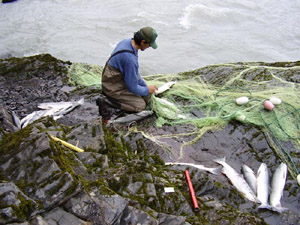
GFA administers and operates both Food, Social and Ceremonial (FSC) fisheries and more recently, an economic fishery on Meziadin sockeye.
Services Overview
GFA's primary purpose is to provide fisheries and wildlife management capability for the Gitanyow Hereditary Chiefs Office (GHCO). In doing this, since 1994, GFA has developed considerable expertise throughout Gitanyow Traditional Territory, especially in the field of fisheries management. GFA fisheries biologists have over 40 years combined experience in aquatic fieldwork and project management. GFA has an experienced crew of technicians, and in the 2011 season will have 5 technicians certified as fisheries technicians through Vancouver Island University. The GFA team has successfully implemented projects for government (Ministry of Forests, Ministry of Environment, Department of Fisheries and Oceans Canada, BC Environmental Assessment Office, BC Hydro), industry (Chemtx Energy Corporation, Syntaris Power Corporation) and various funders (Pacific Salmon Commission, Skeena Watershed Initiative, etc.).
GFA's expertise in aquatic work, in and around Gitanyow Territory, is being increasingly noticed and utilized by industry and government. GFA's local knowledge, pragmatic approach and physical location in northwestern B.C., means they can often do work on shorter notice and at a lower cost than consulting companies that need to travel from the lower mainland or other parts of B.C. GFA commonly provides technical support to consulting companies looking to hire local, First Nations technicians (Rescan Environmental Services). GFA will also partner with consulting companies to assist them in providing local knowledge, expertise and manpower (Environmental Dynamics Incorporated). GFA has a network of professionals to partner with to deliver on multi-disciplinary projects, including engineers, specialized biologists, foresters, hydrologists, etc.
GFA can provide services in the following areas:
The Gitanyow Fisheries Authority (GFA) runs a number of different programs, ranging from stock enumeration wiers to beaver dam breaching, and is also involved in a variety of projects relating to environmental assessment, wildlife management, etc.
GITANYOW FISHERIES AUTHORITY
Box 397, Kitwanga, BC, Canada V0J 2A0
tel: 250-849-5373 fax: 250-849-5375
Staff Contact Information:
Gregory Rush
Fisheries Coordinator
email: gregoryrush@hotmail.com
Mark Cleveland, BSc., RP Bio
Head Fisheries Biologist
email: mark.cleveland7@gmail.com
Kevin Koch, BSc.
Fish and Wildlife Biologist
email: kjk.gfa@gmail.com
Jordan Beblow, BSc.
Fisheries Biologist
email: jbeblow.gfa@gmail.com
Welcome to Gitanyow Territory
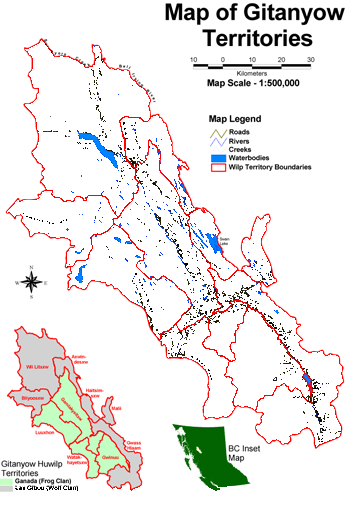 The Gitanyow Fisheries Authority (GFA) is the technical arm of the Gitanyow Hereditary Chiefs (GHC), and provides fisheries, wildlife and overall environmental expertise and services. GFA shares an office with the GHC, which is located in the village of Gitanyow. GFA has been operating since 1997 and in that time has grown to employing 3 full-time biologists, 1 full-time fisheries coordinator and 8-10 seasonal technical staff. GFA conducts salmonid stock assessment, watershed restoration, environmental monitoring, fish and wildlife habitat assessment, environmental impact assessment, research and planning, primarily within the Gitanyow Territory.
The Gitanyow Fisheries Authority (GFA) is the technical arm of the Gitanyow Hereditary Chiefs (GHC), and provides fisheries, wildlife and overall environmental expertise and services. GFA shares an office with the GHC, which is located in the village of Gitanyow. GFA has been operating since 1997 and in that time has grown to employing 3 full-time biologists, 1 full-time fisheries coordinator and 8-10 seasonal technical staff. GFA conducts salmonid stock assessment, watershed restoration, environmental monitoring, fish and wildlife habitat assessment, environmental impact assessment, research and planning, primarily within the Gitanyow Territory.
A driving force behind the creation of the GFA was the perilous state of the Kitwanga River sockeye salmon. This stock was historically a key food fish for the Gitanyow people, as well as a vital component of the highly productive Kitwanga River Watershed ecosystem. The Gitanyow have taken the lead by volunteering to not harvest Kitwanga sockeye as a Food, Social and Ceremonial (FSC) fish since the early 1970's. They were also instrumental in spearheading the Kitwanga Sockeye Recovery Plan in 2005-2006, a collaboration between GFA, the Department of Fisheries and Oceans (DFO) and the Skeena Fisheries Commission (SFC). A key part of the recovery of the Kitwanga sockeye has involved accurate stock assessment (i.e. enumeration), resulting in the construction and operation of both the Kitwanga River Salmon Enumeration Facility and the Kitwanga River Sockeye Smolt Enumeration Facility. Both these stock assessment tools have enabled GFA to obtain accurate counts of sockeye spawners and smolts, with the additional benefits of enabling enumeration of all salmon spawners that migrate into the Kitwanga River.
Starting with the protection of the Kitwanga River sockeye salmon, the GFA has grown into a well established fisheries management team, that now conducts stock assessment work in the Nass River Watershed (Cranberry River, Brown Bear Creek), as well as a variety of work throughout the Gitanyow Traditional Territory. The services of GFA staff are now in demand and have been acquired for work in neighbouring watersheds, such as Sedan Creek and throughout the Kispiox River Watershed.


